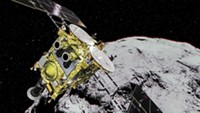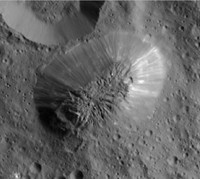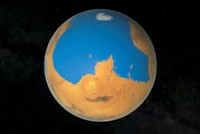Advertisement
Grab your lab coat. Let's get started
Welcome!
Welcome!
Create an account below to get 6 C&EN articles per month, receive newsletters and more - all free.
It seems this is your first time logging in online. Please enter the following information to continue.
As an ACS member you automatically get access to this site. All we need is few more details to create your reading experience.
Not you? Sign in with a different account.
Not you? Sign in with a different account.
ERROR 1
ERROR 1
ERROR 2
ERROR 2
ERROR 2
ERROR 2
ERROR 2
Password and Confirm password must match.
If you have an ACS member number, please enter it here so we can link this account to your membership. (optional)
ERROR 2
ACS values your privacy. By submitting your information, you are gaining access to C&EN and subscribing to our weekly newsletter. We use the information you provide to make your reading experience better, and we will never sell your data to third party members.
Environment
The Moon Is ‘Wetter’ Than First Believed
Geologists use hydroxyl groups in moon rock minerals to extrapolate the amount of water once on the lunar surface
by David Pittman
June 21, 2010
| A version of this story appeared in
Volume 88, Issue 25
Geologists studying moon rocks have found evidence that water once existed on the lunar surface at levels 100 times greater than previously thought (Proc. Natl. Acad. Sci. USA, DOI: 10.1073/pnas.1006677107). Using secondary ion mass spectrometry, Francis M. McCubbin and coworkers at Carnegie Institution for Science, in Washington, D.C., looked for hydroxyl groups in the mineral apatite from lunar samples collected during Apollo missions in the 1970s. The team extrapolated its findings to estimate the water content for the region of the moon from which the samples were collected at 64 ppb to 5 ppm. Previous estimates were less than 1 ppb. “The presence of hydroxyl in apatite from a number of different types of lunar rocks indicates that water may be ubiquitous within the lunar interior,” McCubbin and coworkers note in the paper. The researchers ruled out contamination of samples after they had been collected, observing that hydroxyl groups would have a tough time binding to and penetrating the moon rocks’ surface. The Carnegie Institution study complements the work of Alberto E. Saal of Brown University, who published a paper two years ago in Nature that first countered conventional wisdom that the moon was dry as a bone (C&EN, July 14, 2008, page 34). Saal’s work examined glass beads from one type of lunar volcanic rock.





Join the conversation
Contact the reporter
Submit a Letter to the Editor for publication
Engage with us on Twitter